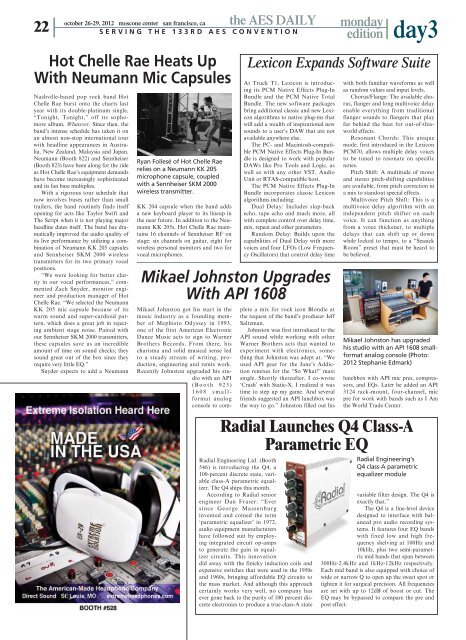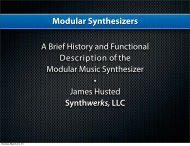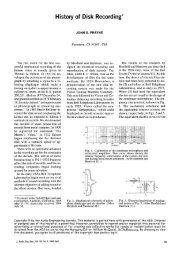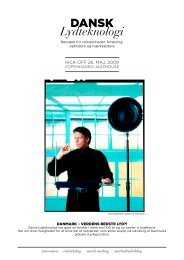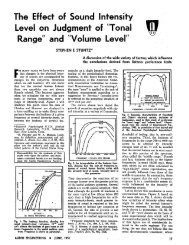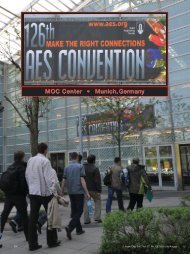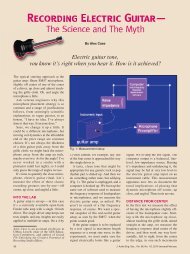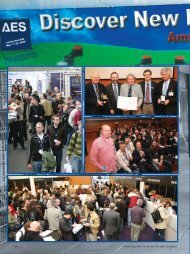Day 3 - Monday Edition - Audio Engineering Society
Day 3 - Monday Edition - Audio Engineering Society
Day 3 - Monday Edition - Audio Engineering Society
Create successful ePaper yourself
Turn your PDF publications into a flip-book with our unique Google optimized e-Paper software.
october 26-29, 2012 moscone center san francisco, ca the AES DAILY<br />
22 monday<br />
day3<br />
Serving the 133rd AeS Convention edition<br />
hot Chelle rae heats Up<br />
With neumann Mic Capsules<br />
Nashville-based pop rock band Hot<br />
Chelle Rae burst onto the charts last<br />
year with its double-platinum single,<br />
“Tonight, Tonight,” off its sophomore<br />
album, Whatever. Since then, the<br />
band’s intense schedule has taken it on<br />
an almost non-stop international tour<br />
with headline appearances in Australia,<br />
New Zealand, Malaysia and Japan.<br />
Neumann (Booth 822) and Sennheiser<br />
(Booth 823) have been along for the ride<br />
as Hot Chelle Rae’s equipment demands<br />
have become increasingly sophisticated<br />
and its fan base multiplies.<br />
With a rigorous tour schedule that<br />
now involves buses rather than small<br />
trailers, the band routinely finds itself<br />
opening for acts like Taylor Swift and<br />
The Script when it is not playing major<br />
headline dates itself. The band has dramatically<br />
improved the audio quality of<br />
its live performance by utilizing a combination<br />
of Neumann KK 205 capsules<br />
and Sennheiser SKM 2000 wireless<br />
transmitters for its two primary vocal<br />
positions.<br />
“We were looking for better clarity<br />
in our vocal performances,” commented<br />
Zach Snyder, monitor engineer<br />
and production manager of Hot<br />
Chelle Rae. “We selected the Neumann<br />
KK 205 mic capsule because of its<br />
warm sound and super-cardioid pattern,<br />
which does a great job in rejecting<br />
ambient stage noise. Paired with<br />
our Sennheiser SKM 2000 transmitters,<br />
these capsules save us an incredible<br />
amount of time on sound checks; they<br />
sound great out of the box since they<br />
require very little EQ.”<br />
Snyder expects to add a Neumann<br />
Ryan Follesé of Hot Chelle Rae<br />
relies on a Neumann KK 205<br />
microphone capsule, coupled<br />
with a Sennheiser SKM 2000<br />
wireless transmitter.<br />
KK 204 capsule when the band adds<br />
a new keyboard player to its lineup in<br />
the near future. In addition to the Neumann<br />
KK 205s, Hot Chelle Rae maintains<br />
16 channels of Sennheiser RF on<br />
stage: six channels on guitar, eight for<br />
wireless personal monitors and two for<br />
vocal microphones.<br />
Mikael Johnston Upgrades<br />
With API 1608<br />
Mikael Johnston got his start in the<br />
music industry as a founding member<br />
of Mephisto Odyssey in 1993,<br />
one of the first American Electronic<br />
Dance Music acts to sign to Warner<br />
Brothers Records. From there, his<br />
charisma and solid musical sense led<br />
to a steady stream of writing, production,<br />
engineering and remix work.<br />
Recently Johnston upgraded his studio<br />
with an API<br />
(Booth 923)<br />
1608 smallformat<br />
analog<br />
console to com-<br />
Lexicon Expands Software Suite<br />
At Truck T1, Lexicon is introducing<br />
its PCM Native Effects Plug-In<br />
Bundle and the PCM Native Total<br />
Bundle. The new software packages<br />
bring additional classic and new Lexicon<br />
algorithms to native plug-ins that<br />
will add a wealth of inspirational new<br />
sounds to a user’s DAW that are not<br />
available anywhere else.<br />
The PC- and Macintosh-compatible<br />
PCM Native Effects Plug-In Bundle<br />
is designed to work with popular<br />
DAWs like Pro Tools and Logic, as<br />
well as with any other VST, <strong>Audio</strong><br />
Unit or RTAS-compatible host.<br />
The PCM Native Effects Plug-In<br />
Bundle incorporates classic Lexicon<br />
algorithms including:<br />
Dual Delay: Includes slap-back<br />
echo, tape echo and much more, all<br />
with complete control over delay time,<br />
mix, repeat and other parameters.<br />
Random Delay: Builds upon the<br />
capabilities of Dual Delay with more<br />
voices and four LFOs (Low Frequency<br />
Oscillators) that control delay time<br />
plete a mix for rock icon Blondie at<br />
the request of the band’s producer Jeff<br />
Saltzman.<br />
Johnston was first introduced to the<br />
API sound while working with other<br />
Warner Brothers acts that wanted to<br />
experiment with electronics, something<br />
that Johnston was adept at. “We<br />
used API gear for the Jane’s Addiction<br />
remixes for the “So What!” maxi<br />
single. Shortly thereafter, I co-wrote<br />
‘Crash’ with Static-X. I realized it was<br />
time to step up my game. And several<br />
friends suggested an API lunchbox was<br />
the way to go.” Johnston filled out his<br />
Radial <strong>Engineering</strong> Ltd. (Booth<br />
546) is introducing the Q4, a<br />
100-percent discrete state, variable<br />
class-A parametric equalizer.<br />
The Q4 ships this month.<br />
According to Radial senior<br />
engineer Dan Fraser: “Ever<br />
since George Massenburg<br />
invented and coined the term<br />
‘parametric equalizer’ in 1972,<br />
audio equipment manufacturers<br />
have followed suit by employing<br />
integrated circuit op-amps<br />
to generate the gain in equalizer<br />
circuits. This innovation<br />
did away with the finicky induction coils and<br />
expensive switches that were used in the 1950s<br />
and 1960s, bringing affordable EQ circuits to<br />
the mass market. And although this approach<br />
certainly works very well, no company has<br />
ever gone back to the purity of 100 percent discrete<br />
electronics to produce a true class-A state<br />
with both familiar waveforms as well<br />
as random values and input levels.<br />
Chorus/Flange: The available chorus,<br />
flanger and long multivoice delay<br />
enable everything from traditional<br />
flanger sounds to flangers that play<br />
far behind the beat for out-of-thisworld<br />
effects.<br />
Resonant Chords: This unique<br />
mode, first introduced in the Lexicon<br />
PCM70, allows multiple delay voices<br />
to be tuned to resonate on specific<br />
notes.<br />
Pitch Shift: A multitude of mono<br />
and stereo pitch-shifting capabilities<br />
are available, from pitch correction in<br />
a mix to standout special effects.<br />
Multivoice Pitch Shift: This is a<br />
multivoice delay algorithm with an<br />
independent pitch shifter on each<br />
voice. It can function as anything<br />
from a voice thickener, to multiple<br />
delays that can shift up or down<br />
while locked to tempo, to a “Seasick<br />
Room” preset that must be heard to<br />
be believed.<br />
Mikael Johnston has upgraded<br />
his studio with an API 1608 smallformat<br />
analog console (Photo:<br />
2012 Stephanie Edmark)<br />
lunchbox with API mic pres, compressors,<br />
and EQs. Later he added an API<br />
3124 rack-mount, four-channel, mic<br />
pre for work with bands such as I Am<br />
the World Trade Center.<br />
Radial Launches Q4 Class-A<br />
Parametric EQ<br />
Radial <strong>Engineering</strong>’s<br />
Q4 class-A parametric<br />
equalizer module<br />
variable filter design. The Q4 is<br />
exactly that.”<br />
The Q4 is a line-level device<br />
designed to interface with balanced<br />
pro audio recording systems.<br />
It features four EQ bands<br />
with fixed low and high frequency<br />
shelving at 100Hz and<br />
10kHz, plus two semi-parametric<br />
mid bands that span between<br />
300Hz-2.4kHz and 1kHz-12kHz respectively.<br />
Each mid band is also equipped with choice of<br />
wide or narrow Q to open up the sweet spot or<br />
tighten it for surgical precision. All frequencies<br />
are set with up to 12dB of boost or cut. The<br />
EQ may be bypassed to compare the pre and<br />
post effect.


